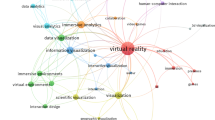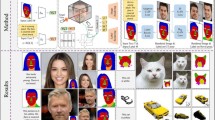Abstract
In the last few years, stereoscopic developed very rapidly and employed in many different fields such as entertainment. Due to the importance of entertainment aspect of stereoscopic 3D (S3D) applications, a review of the current state of S3D development in entertainment technology is conducted. In this paper, a novel survey of the stereoscopic entertainment aspects is presented by discussing the significant development of a 3D cinema, the major development of 3DTV, the issues related to 3D video content and 3D video games. Moreover, we reviewed some problems that can be caused in the viewers’ visual system from watching stereoscopic contents. Some stereoscopic viewers are not satisfied as they are frustrated from wearing glasses, have visual fatigue, complain from unavailability of 3D contents, and/or complain from some sickness. Therefore, we will discuss stereoscopic visual discomfort and to what extend the viewer will have an eye fatigue while watching 3D contents or playing 3D games. The suggested solutions in the literature for this problem are discussed.
Graphical Abstract
Demonstrate the latest stereoscopic applications and devices






Similar content being viewed by others
References
Acuna, K. (2013). 3 Signs that 3D movies are the way of the future. Retrieved 1 March, 2014, from http://www.businessinsider.com/3d-movies-have-a-future-in-hollywood-2013-1.
Bando, T., Iijima, A., et al. (2012). Visual fatigue caused by stereoscopic images and the search for the requirement to prevent them: A review. Displays, 33, 76–83.
Berezin, O. (2010). Digital cinema in russia: Is 3D still a driver for the development of the cinema market? 3D Media, 2010.
Devernay, F., Duchene, S., et al. (2011). Adapting stereoscopic movies to the viewing conditions using depth-preserving and artifact-free novel view synthesis. In Proceedings of the SPIE.
Do, L., Zinger, S., et al. (2011). Warping error analysis and reduction for depth image based rendering in 3DTV. In International Conference on Image Processing (ICIP).
Emoto, M., Nojiri, Y., et al. (2004). Changes in fusional vergence limit and its hysteresis after viewing stereoscopic TV. Displays, 25, 67–76.
Evans, B. J. W. (1997). Pickwell’s binocular vision anomalies. Oxford: Butterworth-Heinemann.
Hoffman, D. M., Girshick, A. R., et al. (2008). Vergence-accommodation conflicts hinder visual performance and cause visual fatigue. Journal of Vision, 8, 33.
Howard, I. P., & Rogers, B. J. (2002). Seeing in depth. New York: Oxford University Press.
Ince, S., Kornad, J. (2008). Occlusion-aware view interpolation. EURASIP Journal on Image and Video Processing, 2008, 803231.
Jeong, Y., Y. Kwan, et al. (2009). Depth-image-based rendering (DIBR) using disocclusion area restoration.In SID symposium digest of technical papers, (pp. 119–122).
Ji, Q., Tanca, J., et al. (2013). Does 3D increase the enjoyment experience? A comparative experiment on the psychological effects of 3D. 3D Research, 4, 1–9.
Karajeh, H. (2012). Intermediate view reconstruction for multiscopic 3D display. PhD Thesis, Durham University, Durham.
Lambooij, M. T. M., IJsselsteijn, W. A., et al. (2007). Visual discomfort in stereoscopic displays: A review. In Stereoscopic displays and Virtual reality systems XIV. Proceedings of the SPIE, (Vol. 6490). Presented at the society of photo-optical instrumentation engineers conference.
Lambooij, M., Fortuin, M. F., et al. (2012). Reading performance as screening tool for visual complaints from stereoscopic content. Displays, 33, 84–90.
Lambooij, M., Murdoch, M. J., et al. (2013). The impact of video characteristics and subtitles on visual comfort of 3D TV. Displays, 34, 8–16.
Lambooji, M., Ijsselsteijn, W., et al. (2009). Visual discomfort and visual fatigue of stereoscopic displays: A review. Journal of Imaging Science and Technology, 53, 1–14.
Masa’deh, R., Shannak, R., et al. (2014). A structural equation modeling approach for determining antecedents and outcomes of students’ attitude toward mobile commerce adoption. Life Science Journal, 10(4), 2321–2333.
Min, D., Kim, D., et al. (2009). 2D/3D free viewvideo generation for 3DTV system. Signal Processing: Image Communication, 24, 31–48.
Obrist, M., Wurhofer, D., et al. (2013). Viewing experience of 3DTV: An exploration of the feeling of sickness and presence in a shopping mall. Entertainment Computing, 4, 71–81.
Pastoor, S. (1991). 3D-television: A survey of recent research results on subjective requirements. Signal Processing: Image Communication, 4, 21–32.
Patel, R. (2010). Global 3-D TV shipments set to soar to 78 million units in 2015, IHS iSuppli Market Research. Retrieved 26 Feb, 2014, from http://www.isuppli.com/display-materials-and-systems/news/pages/global-3-d-tv-shipments-set-to-soar-to-78-million-units-in-2015.aspx.
Patel, R. (2011). Global 3-D TV shipments soar by nearly 500 percent in 2011, IHS iSuppli Market Research. Retrieved 26 Feb, 2014, from http://www.isuppli.com/Display-Materials-and-Systems/News/Pages/Global-3-D-TV-Shipments-Soar-by-Nearly-500-Percent-in-2011.aspx.
Pölönen, M., Järvenpää, T., et al. (2013). Stereoscopic 3D entertainment and its effect on viewing comfort: Comparison of children and adults. Applied Ergonomics, 44, 151–160.
The illustrated 3D movie list. Retrieved 1 October, 2013, from http://www.3dmovielist.com.
Schild, J., LaViola, J., et al. (2012). Understanding User Experience in Stereoscopic 3D Games. In Proceeding of the 2012 ACM annual conference in human factors in computing systems. New York: ACM.
Schild, J. & Masuch, M. (2011). Fundamentals of stereoscopic 3D game design. In ICEC’11 proceedings of the 10th international conference on entertainment computing. Berlin: Springer.
Schild, J., Seele, S., et al. (2011). Integrating stereoscopic video in 3D games. In ICEC’11 proceedings of the 10th international conference on entertainment computing.
Shannak, R., Masa’deh, R., et al. (2010). Information technology investments: A literature review. In The 14th IBIMA conference on global business transformation through innovation and knowledge management: An academic perspective, Istanbul-Turkey, 23rd–24th June (pp. 1356–1368).
Shibata, T., Kim, J., et al. (2011). The zone of comfort: Predicting visual discomfort with stereo displays. Journal of Vision, 11, 1–29.
Smolic, A. (2011). 3D video and free viewpoint video—From capture to display. Pattern Recognition, 44, 1958–1968.
Spiro, L. (2006). A brief history of the stereographs and stereoscopes. Connexions. Retrieved 10 May, 2014, from http://cnx.org/content/m13784/latest/.
Statista. (2013). Number of 3D cinema screens worldwide from 2006 to 2012. Retrieved 14 June, 2014, from http://www.statista.com/statistics/271863/number-of-3d-cinema-screens-worldwide.
Sun, J., Y. Li, et al. (2005). Symmetric stereo matching for occlusion handling. In Proceedings of IEEE conference computer vision Pattern recognition.
Tam, W. J., Stelmach, L. B., et al. (1998). Psychovisual aspects of viewing stereoscopic video sequences. In Proceedings of the SPIE stereoscopic displays and virtual reality system V.
Wheatstone, C. (1838). Contributions to the physiology of vision—Part the first: On some remarkable, and hitherto unobserved, phenomena of binocular vision. Philosophical Transactions of the Royal Society, 128, 371–394.
Wikipedia (In Wikipedia, The Free Encyclopedia). (2014). 3D television/3D channels. Retrieved 1 March, 2014, from http://en.wikipedia.org/wiki/3D_television.
Yano, S. (1991). Experimental stereoscopic high-definition television. Displays, 12, 58–64.
Yousefi, S., Kondori, F. A., et al. (2013). Experiencing real 3D gestural interaction with mobile devices. Pattern Recognition Letters, 34, 912–921.
Zachara, M. & Zagal, J. P. (2009). Challenges for success in stereo gaming: A virtual boy case study. In Proceeding of Advances in Computer Entertainment Technology.
Ziegler, M., Falkenhagen, L., et al. (1998). Evolution of stereoscopic and three-dimensional video. Signal Processing: Image Communication, 14, 173–194.
Author information
Authors and Affiliations
Corresponding author
Rights and permissions
About this article
Cite this article
Karajeh, H., Maqableh, M. & Masa’deh, R. A Review on Stereoscopic 3D: Home Entertainment for the Twenty First Century. 3D Res 5, 26 (2014). https://doi.org/10.1007/s13319-014-0026-3
Received:
Revised:
Accepted:
Published:
DOI: https://doi.org/10.1007/s13319-014-0026-3




